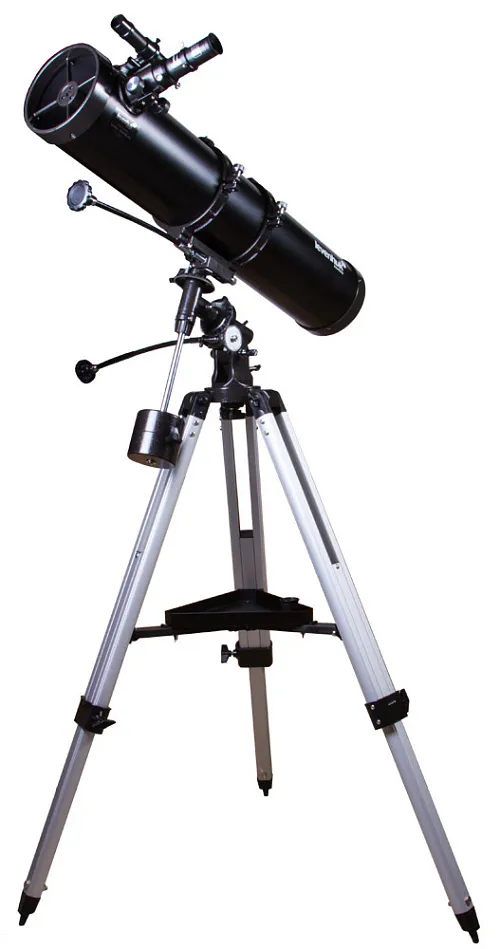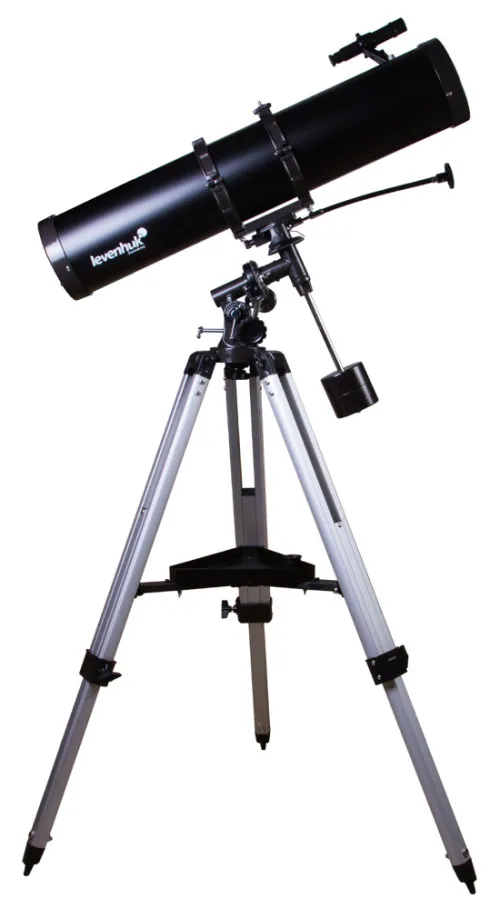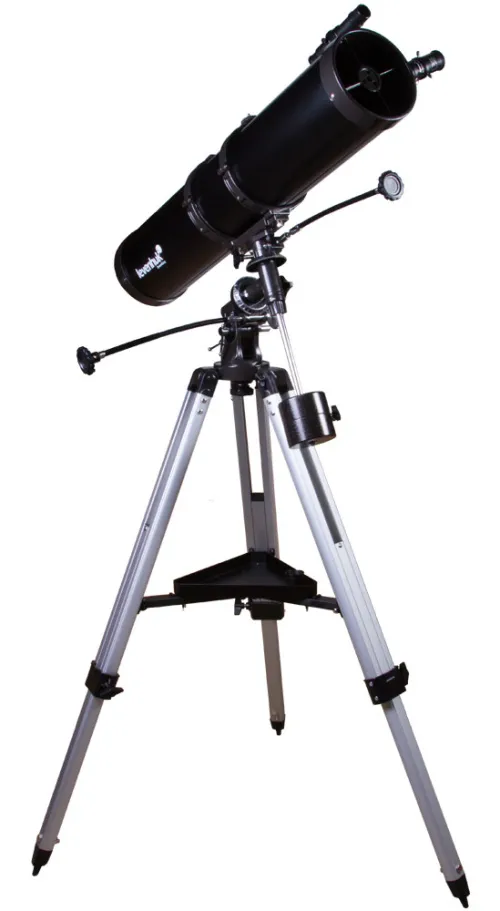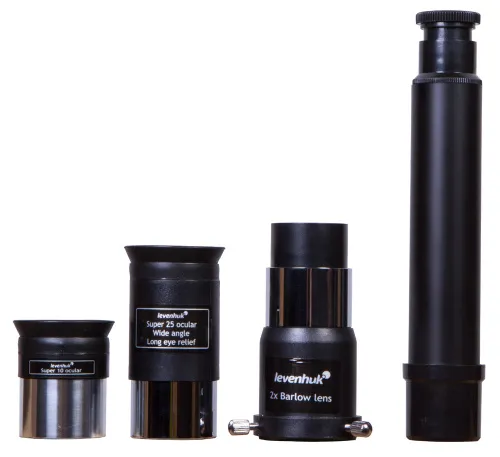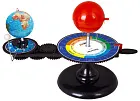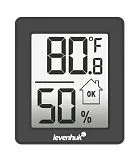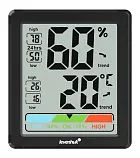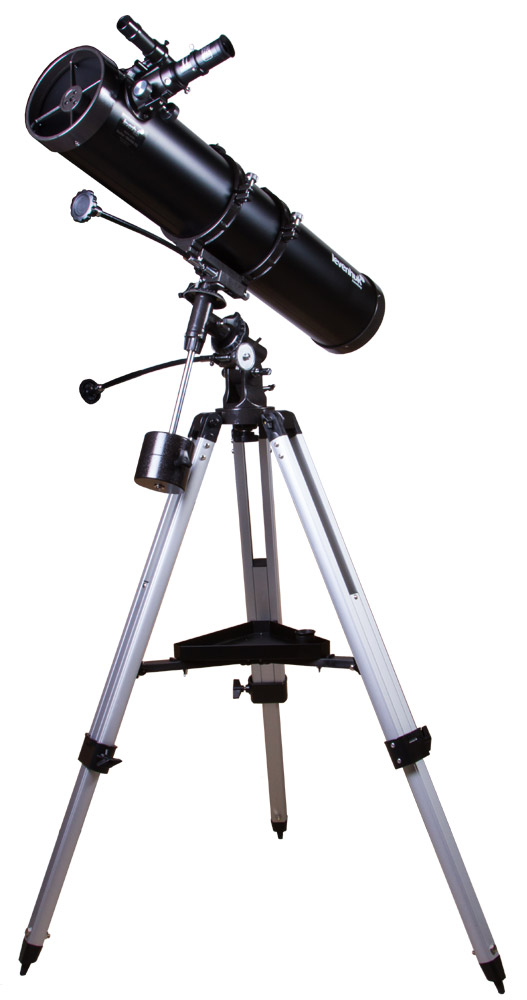Levenhuk Skyline 130x900 EQ Telescope
Newtonian telescope. Aperture: 130mm. Focal length: 900mm
| Product ID | 24296 |
| Brand | Levenhuk, Inc., USA |
| Warranty | lifetime |
| EAN | 0611901508894 |
| Package size (LxWxH) | 19.7x42.9x10.6 in |
| Shipping Weight | 40.2 lb |
Levenhuk Skyline 130x900 EQ is a Newtonian reflector, which is most suitable for the study of deep-sky objects. It is also perfect for observation of planets, even the most remote ones: Jupiter, Saturn, or asteroids and comets. NGC objects, many in high detail, are reachable as well. The telescope provides a clear and sharp image.
Features:
- Suitable deep sky objects study: nebulae, galaxies, globular clusters and faint stars;
- Fairly small overall dimensions for the focal length of 900 millimeters (35.4 inches);
- Contrast and sharp images without distortion;
- Can be used for astrophotography.
The kit includes:
- Telescope optical tube (optical elements inside)
- SUPER 25 and SUPER 10 eyepieces
- Equatorial mount EQ2
- Aluminum tripod
- 2x Barlow lens
- User manual and lifetime warranty
The equatorial mount, as opposed to an azimuth one, when being hovered compensates for the rotation of the Earth and allows more precise tracking of astronomical objects, keeping them within sight through the eyepiece. This mount is perfect for astronomical observations and indispensable for astrophotography. The aluminum tripod has adjustable height.
Two achromatic eyepieces SUPER 10 and SUPER 25 with a 1.25-inch (31.75-millimeter) diameter are included in the package and serve as powerful image correction tools. The optics used in the eyepiece are glass with a special coating. Field of view is 50–52 degrees.
| Product ID | 24296 |
| Brand | Levenhuk, Inc., USA |
| Warranty | lifetime |
| EAN | 0611901508894 |
| Package size (LxWxH) | 19.7x42.9x10.6 in |
| Shipping Weight | 40.2 lb |
| Optical design | reflector |
| Optical scheme | Newtonian |
| Optics coating | silicone dioxide |
| Primary mirror diameter (aperture), in | 5.1 |
| Lens (mirror) shape | spherical |
| Highest practical power, x | 260 |
| Aperture ratio | f/6,9 |
| Resolution threshold, arcseconds | 1.1 |
| Limiting stellar magnitude | 12.5 |
| Eyepieces | SUPER 10mm (90x), SUPER 25mm (36x) |
| Eyepiece barrel diameter, in | 1.25 |
| Barlow lens | 2x |
| Finderscope | optical, 6x24 |
| Focuser | single-speed, rack & pinion, 1.25"; steel and plastics |
| Tripod | aluminum |
| Tripod height (adjustable), in | 27.56–50 |
| Telescope control | manual |
| Mount | equatorial, EQ2 |
| User level | beginners |
| Observed object | deep-sky objects |
Convenient diagrams that describe how to install additional accessories on refractors and catadioptric telescopes
Find out how to assemble a telescope on an example of the Levenhuk Skyline 90x900 EQ telescope
This short guide will help you avoid typical mistakes and learn more about telescope and mounting types
The basics of astronomical observations for beginners
In this article we have gathered answers to some of the most frequently asked questions about telescopes
The most interesting celestial objects you can observe with Levenhuk telescopes
How telescopes work?
You can actually perform observations from your balcony!
All about telescope sizes, types, magnification, and mounts
Learn how to set up and use the telescope properly
Astronomy in light-polluted skies. Find out what you can observe in the city
Read an interesting comprehensive article on telescopes for little astronomers
The pictures are made with Levenhuk telescopes
Celestial objects you can observe with telescopes of different apertures
Colored and vivid images of galaxies, planets and star clusters entrance everyone who is fascinated by boundless space
Find an interesting review on the history of the changes to a refracting telescope
To make the process of choosing a telescope easier, we will tell you about the characteristics of the most popular types of telescopes today
Learn everything you need to know about refractor telescopes to make the right choice
Is there any additional information you might need?
The maximum useful magnification is 260x.
You can reach different magnifications with the help of different accessories. In order to calculate the magnification you need to divide the telescope's focal length by eyepiece's focal length.
Without Barlow lens you will reach: 1) 25mm eyepiece - (900/25) = 36x; 2) 10mm eyepiece - (900/10) = 90x.
With a 2x Barlow lens that comes in a kit, the telescope's focal length will be 900X2 = 1800.
Magnification with the 25 mm eyepiece will be (1800/25) = 72x, with the 10mm eyepiece (1800/10) = 180x.
In order to reach the maximum useful magnification of 260x, you will need to buy a 3-4 mm eyepiece.
Is there any additional information you might need?
binary stars with angular separation of over 1", faint stars (up to 13 stellar magnitude);
details of lunar highlands and craters (3-4 km in diameter);
spots in the atmosphere of Venus may be seen with a blue filter;
numerous details on the surface of Mars during oppositions;
features in the atmospheric bands of Jupiter;
atmospheric bands on Saturn;
plethora of faint asteroids and comets;
hundreds of clusters, nebulae and galaxies;
spiral features of the brightest galaxies (M33, M51);
a large number of objects from NGC (features may be observed on most objects).
Is there any additional information you might need?
If you want to get a direct image, you need to search for erecting prism for Newtonian telescopes. This is a standard erecting eyepiece which can be found on the internet, all you need is to make sure you get the eyepiece with 1.25'' barrel diameter. Is there any additional information you might need?
The primary mirror of the Levenhuk Skyline 130х900 EQ Telescope is parabolic.
Is there any additional information you might need?
Looking forward to your reply.
Thank you for interest in Levenhuk products!
The main advantage of reflecting telescopes is complete absence of any chromatic aberrations.
Is there any additional information you might need?
Looking forward to your reply.
Yes, the Levenhuk Skyline 130x900 EQ Telescope has the parabolic primary mirror. Is there any additional information you might need? Looking forward to your reply.
Yes, you can distinguish galaxy spiral formation by looking through this telescope.
How can I get colourful images?
Color images are obtained by adding hundreds of pictures taken with the camera. This is done automatically by the software.
1. Is it worth trying to use the telescope for astrophotography (including Saturn, Jupiter, the Moon) through the use of Canon 450D?
2. Is it worse than Skymatic 135 GTA at observing planets and deep-sky objects?
3.Is it possible to distinguish galactic, nebulae and cluster structure or do i need more powerful telescope?
thanx in adv.
2. No, Levenhuk Skyline 130x900 EQ and Skymatic 135 GTA will give you similar results when observing planets and deep-sky objects.
3. Yes, it's possible, starting with aperture of 130 mm you can do that.
Answer:
Specify which optical accessories you use?
The ones that are included in the kit: 2x Barlow lens, 10 and 25 eyepieces.

